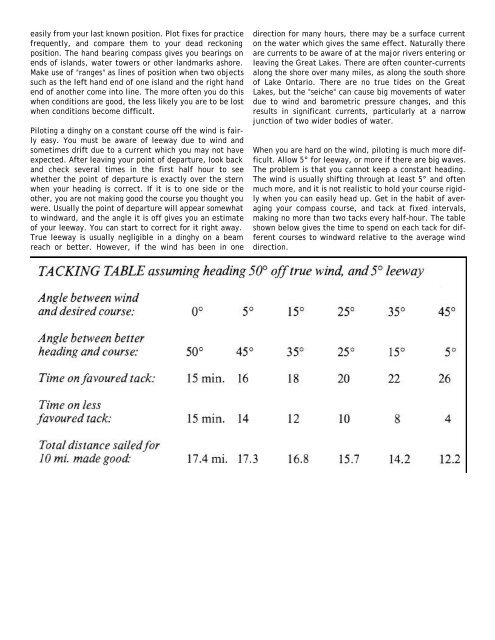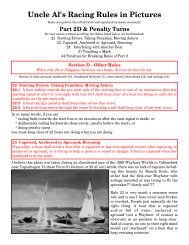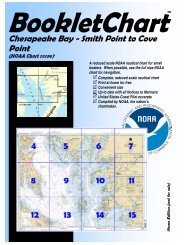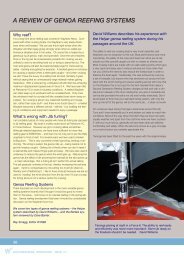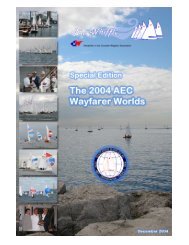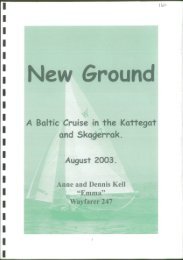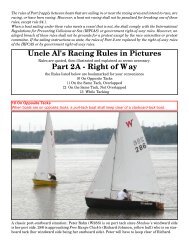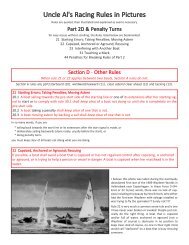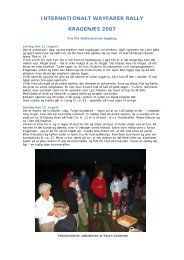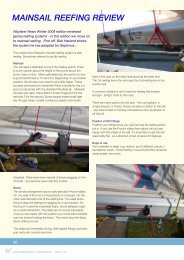Contents - Wayfarer Institute of Technology
Contents - Wayfarer Institute of Technology
Contents - Wayfarer Institute of Technology
You also want an ePaper? Increase the reach of your titles
YUMPU automatically turns print PDFs into web optimized ePapers that Google loves.
easily from your last known position. Plot fixes for practice<br />
frequently, and compare them to your dead reckoning<br />
position. The hand bearing compass gives you bearings on<br />
ends <strong>of</strong> islands, water towers or other landmarks ashore.<br />
Make use <strong>of</strong> "ranges" as lines <strong>of</strong> position when two objects<br />
such as the left hand end <strong>of</strong> one island and the right hand<br />
end <strong>of</strong> another come into line. The more <strong>of</strong>ten you do this<br />
when conditions are good, the less likely you are to be lost<br />
when conditions become difficult.<br />
Piloting a dinghy on a constant course <strong>of</strong>f the wind is fairly<br />
easy. You must be aware <strong>of</strong> leeway due to wind and<br />
sometimes drift due to a current which you may not have<br />
expected. After leaving your point <strong>of</strong> departure, look back<br />
and check several times in the first half hour to see<br />
whether the point <strong>of</strong> departure is exactly over the stern<br />
when your heading is correct. If it is to one side or the<br />
other, you are not making good the course you thought you<br />
were. Usually the point <strong>of</strong> departure will appear somewhat<br />
to windward, and the angle it is <strong>of</strong>f gives you an estimate<br />
<strong>of</strong> your leeway. You can start to correct for it right away.<br />
True leeway is usually negligible in a dinghy on a beam<br />
reach or better. However, if the wind has been in one<br />
direction for many hours, there may be a surface current<br />
on the water which gives the same effect. Naturally there<br />
are currents to be aware <strong>of</strong> at the major rivers entering or<br />
leaving the Great Lakes. There are <strong>of</strong>ten counter-currents<br />
along the shore over many miles, as along the south shore<br />
<strong>of</strong> Lake Ontario. There are no true tides on the Great<br />
Lakes, but the "seiche" can cause big movements <strong>of</strong> water<br />
due to wind and barometric pressure changes, and this<br />
results in significant currents, particularly at a narrow<br />
junction <strong>of</strong> two wider bodies <strong>of</strong> water.<br />
When you are hard on the wind, piloting is much more difficult.<br />
Allow 5° for leeway, or more if there are big waves.<br />
The problem is that you cannot keep a constant heading.<br />
The wind is usually shifting through at least 5° and <strong>of</strong>ten<br />
much more, and it is not realistic to hold your course rigidly<br />
when you can easily head up. Get in the habit <strong>of</strong> averaging<br />
your compass course, and tack at fixed intervals,<br />
making no more than two tacks every half-hour. The table<br />
shown below gives the time to spend on each tack for different<br />
courses to windward relative to the average wind<br />
direction.


